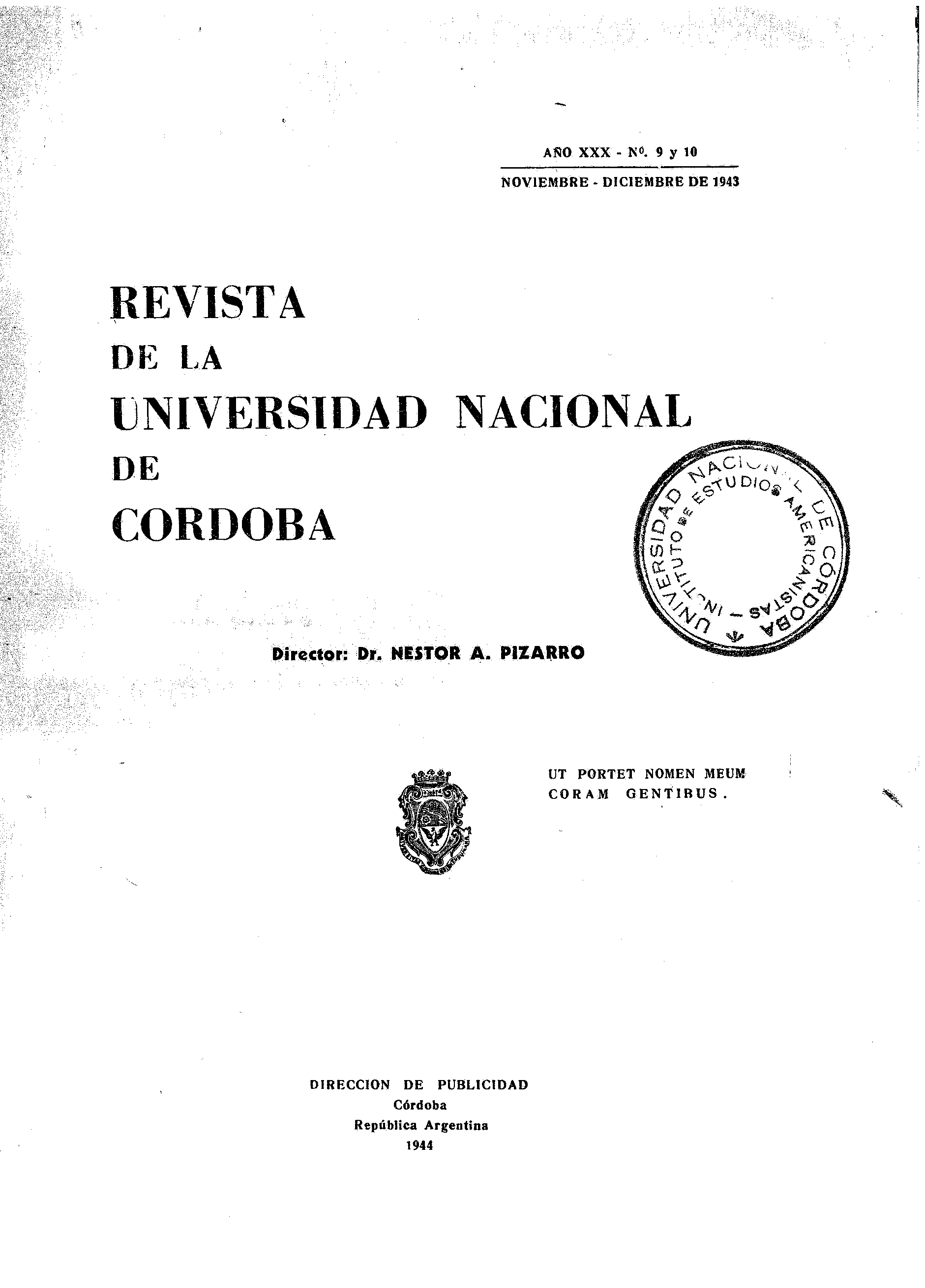Outline for a history of the discovery and conquest of Cordoba.
Keywords:
Gaboto Expedition, Comechingones Mountain Range, Francisco de Villagra, Conlara ValleyAbstract
This short chapter, which will be part of our next book "Los Comechingones", is really an outline for a history of the discovery and conquest of the Cordoba territory. It is written to serve the purposes of that book, hence the need to have incorporated what refers to the discovery of the Conlara Valley, largely belonging today to the province of San Luis, and to circumscribe it only to the sixteenth century. We consider three discovering currents: the one from the East, the one from the North and the one from the West. Most of these currents were in search of the fabulous country of the Caesars, uncertain and shifting like the spirit of the conquerors. But for all of them, Cordoba was only a landmark; either for the Caesars or for the Rio de la Plata.
References
l. -Archivo Municipal de Córdoba. Córdoba, 1884.
2.-CABRERA PABLO. Córdoba del Tucumán prehispana y proto-histórica. Córdoba, 1932.
3. -CABRERA PABLO. Córdoba de la Nueva Andalucía. Córdoba, 1933.
4. -CABRERA PABLO. Los aborígenes del país de Cuyo. Córdoba, 1929.
5. -CARTA DE LUIS RAMÍREZ (1528), EN EDUARDO MADERO, HISTORIA DEL PUERTO DE BUENOS AIRES, apéndice 8. Buenos Aires, 1902.
6. -CIEZA DE LEÓN PEDRO. Tercero Libro de las Guerras civiles del Perú el cual se llama La Guerra de Quito, en Historiadores de Indias, t. II, Madrid, 1909.
7. -FERNÁNDEZ DIEGO. Primera parte de la Historia del Perú, Tomo II, Edición de la Biblioteca Hispania. Madrid, 1914.
8. -FURLONG P. GUILLERMO. Cartografía Jesuítica del Río de la Plata. Publicaciones del Instituto de Investigaciones Históricas de la Facultad de Filosofía y Letras, N°. LXXI. Buenos Aires, 1936.
9. -GEZ JUAN W. Historia de la provincia de San Luis. Buenos Aires, 1916.
10. -GOBERNACIÓN DEL TUCUMÁN. CORRESPONDENCIA DE LOS CABILDOS EN EL SIGLO XVI. (Colección Levillier). Madrid, 1918.
11. -GOBERNACIÓN DEL TUCUMÁN. PROBANZAS DE MÉRITOS Y SERVICIOS DE LOS CONQUlSTADORES. (Colección Levillier).
12. -GRENÓN P. (S. J.). El Libro de Mercedes. Córdoba, 1930.
13.-HERRERA ANTONIO. Historia General de los hechos de los Castellanos en las Islas y Tierra Firme del Mar Odéano. Madrid, 1728.
14.-JAIME FREYRE RICARDO. El Tucumán Colonial (Documentos y Mapas del Archivo de Indias). Vol. I (único). Buenos Aires, 1915.
15. -LA AUDIENCIA DE CHARCAS. CORRESPONDENCIA DE PRESIDENTES Y OIDORES (Colección Levillier). Madrid, 1918.
16. -LEVILLIER ROBERTO. Nueva Crónica de la Conquista del Tucumán. Madrid, Varsovia 1926, 1928.
17. -MATIENZO JUAN. Gobierno del Perú. (Edición de la Facultad de Filosofía y Letras de la Universidad de Buenos Aires). Buenos Aires, 1910.
18. -MEDINA J. T. Colección de Documentos Inéditos para la Historia de Chile (1518-1818). Santiago de Chile1 1898.
19. -LOZANO PEDRO. Historia de la conquista del Paraguay, Río de la Plata y Tucumán. Edición Andrés Lamas. Buenos Aires, 1874.
Downloads
Published
Issue
Section
License
Copyright (c) 1943 Universidad Nacional de Córdoba

This work is licensed under a Creative Commons Attribution-NonCommercial-ShareAlike 4.0 International License.
Commercial use of the original work and any derivative works is not permitted, and distribution of derivative works must be made under a license equal to that which governs the original work.

 Antonio Serrano (Paraná, March 7, 1899 - Córdoba, December 12, 1982) was an Argentine archaeologist. As the first academic antecedent to highlight, we can mention his belonging to what was called "La Generación del '17" (The Generation of '17). The Asociación Estudiantil Pro-Museo Popular was a group of students between fifteen and eighteen years old from the Colegio de Concepción del Uruguay and the Escuela Normal de Paraná who promoted the creation of the Museum in their hometown. As the first Director of the Popular Museum he was one of the initiators of the University Reform of Córdoba in 1918. In 1917 he began to build an archive and library that 60 years later would be donated to the Provincial Library.
Antonio Serrano (Paraná, March 7, 1899 - Córdoba, December 12, 1982) was an Argentine archaeologist. As the first academic antecedent to highlight, we can mention his belonging to what was called "La Generación del '17" (The Generation of '17). The Asociación Estudiantil Pro-Museo Popular was a group of students between fifteen and eighteen years old from the Colegio de Concepción del Uruguay and the Escuela Normal de Paraná who promoted the creation of the Museum in their hometown. As the first Director of the Popular Museum he was one of the initiators of the University Reform of Córdoba in 1918. In 1917 he began to build an archive and library that 60 years later would be donated to the Provincial Library.




